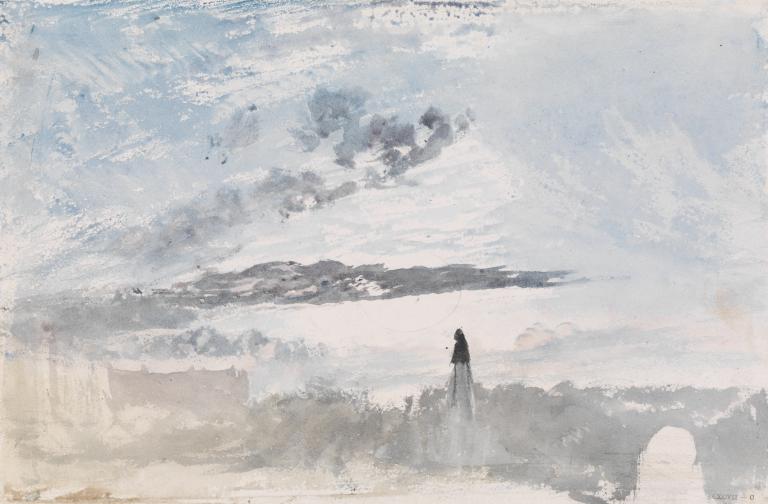J.M.W. Turner
>
1819-29 Italy and after
>
Little Liber c.1823-6
>
Artwork
Joseph Mallord William Turner Bridge and Monument c.1823-6
Joseph Mallord William Turner,
Bridge and Monument
c.1823-6
Joseph Mallord William Turner 1775–1851
Bridge and Monument circa 1823–6
D17193
Turner Bequest CXCVII C
Turner Bequest CXCVII C
Pencil and watercolour on white wove paper, 183 x 276 mm
Blind-stamped with Turner Bequest monogram towards bottom right
Stamped in black ‘CXCVII – C’ bottom right
Blind-stamped with Turner Bequest monogram towards bottom right
Stamped in black ‘CXCVII – C’ bottom right
Accepted by the nation as part of the Turner Bequest 1856
Exhibition history
1904
National Gallery, London, various dates to at least 1904 (719).
1991
Turner: The Fourth Decade: Watercolours 1820–1830, Tate Gallery, London, January–May 1991 (22, reproduced).
1998
Moonlight and Firelight: Watercolours from the Turner Bequest, Tate Gallery, London, July–November 1998 (no catalogue).
2007
Hockney on Turner Watercolours, Tate Britain, London, June 2007–February 2008 (no number, reproduced in colour).
Engraved:
(see main catalogue text)
(see main catalogue text)
References
1913
W[illiam] G[eorge] Rawlinson, The Engraved Work of J.M.W. Turner, R.A., vol.II, London 1913, p.389 no.807, ‘Bridge and Monument’ (possibly referring to the present work; see main catalogue entry).
1904
E.T. Cook and Alexander Wedderburn eds., Library Edition: The Works of John Ruskin: Volume XIII: Turner: The Harbours of England; Catalogues and Notes, London 1904, p.640 no.719, as ‘Study of Sky’.
1909
A.J. Finberg, A Complete Inventory of the Drawings of the Turner Bequest, London 1909, vol.I, p.602, CXCVII C, as ‘Study of sky’, circa 1816.
1991
Ian Warrell, Turner: The Fourth Decade: Watercolours 1820–1830, exhibition catalogue, Tate Gallery, London 1991, pp.37–8 no.22, reproduced, as ‘Study for “Bridge and Monument”’, circa 1820–5.
1996
Gillian Forrester, Turner’s ‘Drawing Book’: The Liber Studiorum, exhibition catalogue, Tate Gallery, London 1996, pp.26 note 140, 152 note 7.
2007
David Blayney Brown, Turner Watercolours, exhibition catalogue, Tate Britain, London 2007, reproduced p.63 (colour), as ‘Bridge and Monument’, circa 1820–5.
This light-filled but ambiguous composition’s ‘Monument’ has been compared to a lighthouse, like that in the ‘Little Liber’ Shields Lighthouse (Tate D25431; Turner Bequest CCLXIII 308) or a seaside column like the one commemorating Nelson in Turner’s watercolour Yarmouth Sands of about 1825,1 suggesting that the form on the skyline to the left may be a ship’s hull, with the silhouetted ‘Bridge’-like form on the right actually a negative shape defining the bright reflection of the moon, hidden in cloud above alongside the setting sun at the centre, thus combining the two light sources as in the ‘Little Liber’ St Michael’s Mount design (Tate D25434; Turner Bequest CCLXIII 311).2 However, the central disk, partly obscured by a band of dark drifting cloud, is left white but loosely ringed in pencil against a white and pale blue sky, and itself suggests the moon; there appears to be no indication of further heavy cloud or a hidden light source on the right. Turner’s design thus remains open to interpretation and speculation. Gillian Forrester has compared the subject and technique to the late, unpublished Liber Studiorum design Moonlight on the Medway (see under Tate D25451; Turner Bequest CCLXIII 328) which she dates to about 1824, with this and other ‘Little Liber’ designs.3
Andrew Wilton does not mention the present sheet in relation to the ‘Little Liber’ his catalogue of Turner’s watercolours, but suggests instead a link to another ‘colour beginning’ (Tate D25374; Turner Bequest CCLXIII 252),4 presently called A Stormy Landscape with an Obelisk and a Classical Portico and listed by Finberg as ‘The obelisk. (?design for so-called “Little Liber.”)’, which shares only the fundamentals of a low horizon and a vertical feature, shown in that case pale against billowing, inky clouds.
The current composition, as recognise by Warrell,5 was the one engraved in mezzotint,6 traditionally ascribed to Turner himself (see the ‘Little Liber’ introduction). Rawlinson does not state whether a plate was found in Turner’s studio after his death, but Dupret states that a ‘corroded steel plate’ was sold in 1873, and some ‘mediocre’ later impressions were taken;7 it is unclear whether it is listed in the 24 March 1873 Christie’s sale of prints from Turner’s studio (see the Introduction). The development of the design through two trial proof stages is described by Rawlinson and Dupret, although the forms are no clearer in the print; Rawlinson mentions a ‘very slight drawing ... in the National Gallery’, perhaps recognising the present watercolour, but Dupret refers only to the ‘tenuous’ link to the Stormy Landscape watercolour.8
The two stages of the print are distinguished by a lessening of the brilliance of the sky in the second. Tate’s impression (T04916) is a late nineteenth-century one, with signs of heavy pitting across the sky. Although the watercolour has been assigned to circa 1820–25,9 the range suggested here is in line with the general consensus on the overall dating of the ‘Little Liber’ (see the Introduction).
Andrew Wilton, J.M.W. Turner: His Life and Work, Fribourg 1979, p.390 no.776, reproduced; see also Andrew Wilton, Turner Watercolors: An Exhibition of Works Loaned by The Trustees of the British Museum, exhibition catalogue, Cleveland Museum of Art 1977, p.39 no.20, reproduced.
W[illiam] G[eorge] Rawlinson, The Engraved Work of J.M.W. Turner, R.A., vol.I, London 1908, p.cxi, and vol.II 1913, pp.211, 389 no.807.
Technical notes:
Verso:
Blank save for being inscribed in pencil ‘[...0]4’ top left, partly obscured by mount, in brown in with a cross centre right, and in pencil ‘CXCVII – C’ bottom centre; stamped in black ‘[Turner Bequest monogram] | CXCVII – C’ bottom left.
Matthew Imms
November 2011
How to cite
Matthew Imms, ‘Bridge and Monument c.1823–6 by Joseph Mallord William Turner’, catalogue entry, November 2011, in David Blayney Brown (ed.), J.M.W. Turner: Sketchbooks, Drawings and Watercolours, Tate Research Publication, December 2012, https://www

